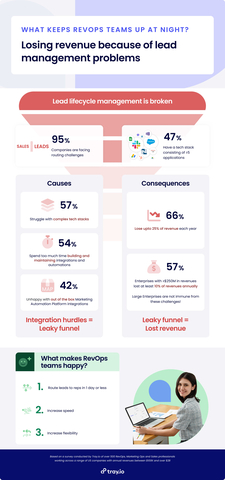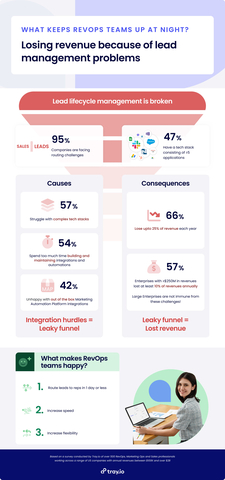SAN FRANCISCO--(BUSINESS WIRE)--Most companies (95.4%) are facing annual revenue loss due to operational issues related to lead lifecycle management, according to new research released today from Tray.io, the leader in low-code automation and integration. Of the companies who reported $100M or more in revenue, more than half (68%) estimate a loss of at least $5M—five percent of their revenue—annually. The research analyzed current challenges Sales Ops, Marketing Ops and RevOps (Revenue Operations) teams face when attempting to deliver high-quality leads through their marketing and sales pipelines, including time-consuming processes, lack of integration capabilities and complex tech stacks. The top three business objectives of operations teams surveyed include increasing the total volume of deals moving through the sales process and converting into revenue, delivering high-quality leads and improving engagement rates on content. However, these efforts are often obstructed by inefficiencies in the many steps involved in delivering leads through the sales cycle from initial capture to the point of sale—a staggering 88.6% of teams report issues with their lead lifecycle management processes.
“Without a reliable and scalable lead lifecycle management process, companies will continue to lose out on high-quality leads and the resulting revenue,” said Dominic Lewis, CRO and co-founder of Tray.io. “Companies must deliver more personalized experiences in a timely manner for a large number of buyers. This puts tremendous pressure on operations teams to not only save time and cut costs but also establish competitive differentiation through superior customer experiences.”
RevOps Professionals are Hamstrung by Manual Tasks and Limitations of Legacy Automation and Integration Tools
Nearly three out of four companies (71.8%) estimate at least five percent in annual revenue loss due to operational issues related to lead lifecycle management. At a time when cost saving and operational efficiency are top of mind, more companies are turning to RevOps to increase sales productivity and ultimately improve customer retention.
The majority of teams (80.8%) report a clear desire to route leads—from inbound capture to sales—in one day or less. However, inefficiencies in the lead lifecycle management process prevent almost a third of companies (31.8%) from achieving this goal.
These inefficiencies are due to time-consuming, manual and repetitive processes; lack of integration capabilities; and a complex tech stack consisting of many siloed SaaS apps, with almost half of companies reporting the use of five or more applications in their lead lifecycle management process across teams.
- Time-consuming, manual and repetitive processes (45.8%)
- Lack of integration capabilities (32.8%)
- Complex tech stack consisting of many siloed SaaS apps (27.6%)
- Use of five or more applications in their lead lifecycle management process across teams (45.8%)
These issues have a direct impact on revenue performance, contributing to slower response rates (46.7%), higher sales and marketing costs (45.8%) and lost leads (39.8%).
RevOps Professionals Agree: Yesterday’s Automation Solutions Can’t Fix Today’s Lead Lifecycle Management Needs
According to the survey, 75.4% of companies are either leveraging automation and integration tools or are building integrations and automated workflows in-house to help improve their lead lifecycle management. However, these solutions still pose challenges including complexity, lack of resiliency and insufficient customization—all of which contribute to the growing gap between what businesses need and actual results. Nearly all (99.4%) of companies leveraging an automation and integration tool report experiencing the following issues:
- Complexity of the tool(s) (49.7%)
- Need for deeper resiliency, scalability, governance and compliance capabilities (43.1%)
- Insufficient capabilities and lack of customizability with out-of-the-box integrations provided by their Marketing Automation Platform (41.6%)
Additionally, companies who build in-house integrations and automated workflows for lead lifecycle management also face roadblocks:
- 57.1% of respondents reveal they are struggling with complex tech stacks and 53.7% indicate they are spending extensive time building and maintaining integrations and automations
- 29.9% of respondents report experiencing a lack of engineering resources
The Future of Successful Lead Lifecycle Management Starts with Low-code Automation
Companies are clearly struggling to fill the gaps in their lead lifecycle management processes, leaving ample room to improve revenue, increase customer retention and reduce cost and risk. When asked what respondents would most like to improve about their lead management processes, 40.2% of respondents revealed they want to increase speed, 29.7% want to increase flexibility and 18.3% want to enhance the reliability of their leads.
“The adoption of low code is the first step to maximizing the potential of RevOps and lead lifecycle management. Unlike iPaaS products designed for infrastructure integration that are slow and do not deliver customized experiences at scale, low-code automation enables teams to achieve a more sophisticated level of alignment across departments and dedicate their time and efforts to what's most important: building strategic, tailored customer experiences,” concluded Lewis.
Survey Methodology
The Tray.io “Understanding Lead Lifecycle Management Processes” survey findings are based on the results of an online survey that examined the opinions of 518 U.S.-based RevOps professionals at organizations with 250 or more employees, including: 285 managers, 143 directors, 28 vice presidents, 17 senior vice presidents and 45 C-level executives.
To download the “Understanding Lead Lifecycle Management Processes” survey infographic, visit https://tray.io/revops-announcement.
About Tray.io
Tray.io is a low-code automation platform that can easily turn unique business processes into repeatable and scalable workflows that evolve whenever business needs change. Unlike iPaaS solutions, which are expensive, complex, and code-intensive, Tray.io’s flexible self-service platform makes it simple to build integrations using any API and connect enterprise applications at scale without incremental costs. Process innovation is today’s competitive advantage since companies can no longer differentiate on their tech stack alone. The promise of SaaS led to an avalanche of siloed point solutions that require businesses to force their processes into rigid, predetermined schema. The Tray Platform removes these limitations, empowering both non-technical and technical users to create sophisticated workflow automations that streamline data movement and actions across multiple applications. Freed from tedious and repetitive tasks, product leaders and IT are able to uplevel their skill set with automation to unlock their full potential and do things in a way that’s right for their business. Love your work. Automate the rest.™




